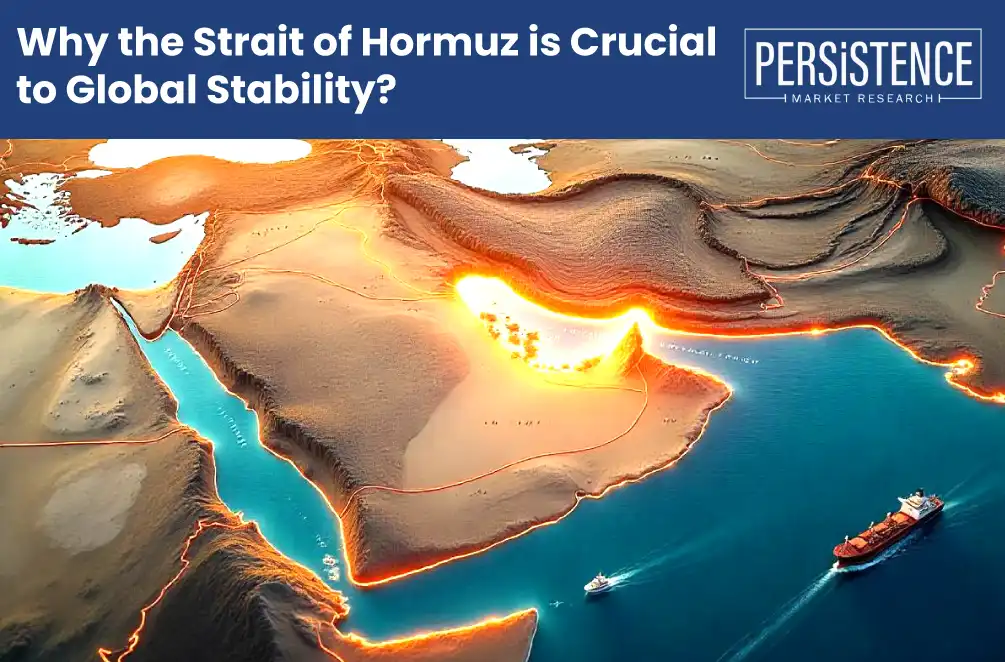- Blog
- Strait Of Hormuz Global Stability Importance
Why the Strait of Hormuz is Crucial to Global Stability?
Published On : 26 Jun 2025
In the tense and unpredictable Middle East lies a narrow stretch of water that plays a huge role in the world economy: The Strait of Hormuz. This small waterway is the main route for oil and gas exports from the Persian Gulf. As global tensions rise, understanding its importance, the risks of a blockade, and what the world can do about it is more important than ever.

Geographic Location and Strategic Importance
The Strait of Hormuz sits between Iran in the north and Oman and the United Arab Emirates (UAE) in the south. It’s around 90 nautical miles long and, at its narrowest point, the shipping lane is just two miles wide. This makes it one of the most sensitive maritime chokepoints in the world.
It’s the only sea route that connects the Persian Gulf to the Arabian Sea and the rest of the world. Oil and liquefied natural gas (LNG) from countries like Saudi Arabia, Iran, Iraq, Kuwait, and the UAE pass through it daily. According to the U.S. Energy Information Administration, around 20 million barrels of oil or 20% of global oil consumption move through the strait each day, along with a third of the world’s LNG.
Historically, the strait has been both a trade route and a battlefield. From ancient times to the Iran-Iraq War of the 1980s, it has been a flashpoint of tension and conflict. Its role in global energy markets makes it a vital lifeline for economies worldwide.
Recent Tensions and Global Attention
In June 2025, the world’s attention once again turned to the Strait of Hormuz after U.S. airstrikes on Iranian nuclear sites. In response, Iran threatened to block the strait. While many experts believe such a move would be difficult to carry out, even the threat has created serious concern.
Oil tankers have collided in the region, and some have turned around mid-route due to rising risks. Iran’s increased military activity around the strait has also added to fears. These developments have made oil markets nervous. For example, Brent crude oil jumped from US$ 69 to US$ 74 per barrel in just one day, showing how sensitive markets are to events around the strait.
Consequences of a Blockade
A blockade of the Strait of Hormuz would trigger a global energy crisis with profound economic and geopolitical consequences. The strait handles approximately 30-33 million barrels of oil equivalent daily, including 21 million barrels of crude and products and significant LNG and liquefied petroleum gas shipments.
A closure would create an immediate supply shock, potentially pushing oil prices above US$ 100 per barrel, as predicted by economists. Historical disruptions, like the 1973 oil embargo, illustrate the devastating impact of supply shortages, which led to inflation and economic stagnation. Today, higher oil prices would increase costs for transportation, manufacturing, and agriculture, driving inflation and reducing consumer purchasing power.
Import-dependent nations, particularly in Europe and Asia, would face fuel shortages, disrupting daily life and critical services. Countries like the U.S., which has a military presence in the region, might be forced to respond, raising the risk of wider conflict. Even Iran would be affected, as 90% of its own oil exports depend on the strait, mostly heading to China.
Long-term Impacts and Alternatives
If the strait stays closed for a long time, countries will need to rethink how they manage energy. Many are already investing in solar, wind, and nuclear power, but replacing oil and gas will take time.
Some backup options exist. Saudi Arabia has a pipeline, the Petroline, that can carry 5 million barrels per day to the Red Sea. The UAE also uses a pipeline from Abu Dhabi to Fujairah that handles 1.5 million barrels daily. However, these routes can't replace the full volume that passes through the Strait of Hormuz. They are also at risk from attacks, like those seen on Saudi infrastructure by Houthi rebels.
The UAE is building up oil storage at Fujairah, trying to become a global energy hub. Still, this doesn't fix the short-term risks. On the diplomatic side, enforcing maritime laws, like the UN Convention on the Law of the Sea, is vital. Countries may also strengthen naval patrols in the region. Strategic oil reserves held by the U.S., China, and others can offer temporary relief, but long-term energy security requires serious changes.
Conclusion
The Strait of Hormuz is more than just a narrow strip of water. It’s a vital link in the global energy chain, carrying a fifth of the world’s oil and a third of its LNG. When tensions rise, the whole world feels the impact.
A blockade could cause oil prices to skyrocket and economies to slow down. But even temporary disruptions show how risky it is to rely on one fragile passage. By investing in clean energy, improving alternate routes, and working together diplomatically, the world can reduce this risk and ensure greater global stability in the future.
Industry Report

Request Report Sample
Your privacy is important to us; your data is secure
Contact Us
Latest Reports
-
Piezoresistive Pressure Sensor Market by Sensor Type (Absolute, Gauge, Differential, Sealed), Pressure Range (Low Pressure (<10 kPa), Medium Pressure (10 kPa – 1000 kPa), High Pressure (>1000 kPa)), End-Use Industry (Automotive & Transportation, Industrial Manufacturing, Healthcare, Aerospace & Defense, Electronics) and Regional Analysis for 2026-2033
-
Aquarium Accessories Market by Product Type (Filtration Items, Lights & Hoods, Temperature Control Systems, Others), End-User (Residential, Commercial), Distribution Channel (Online, Offline), and Regional Analysis for 2026-2033
-
Oxygen Therapy Market by Product Type (Compressed Oxygen, Concentrated Oxygen, Liquid Oxygen), Disease (Respiratory Disorder, Cardiovascular Disease, Sleep Apnea, Pneumonia), End-User (Hospitals, Home Healthcare, Clinics), and Regional Analysis for 2026-2033
-
Air Curtains Market by Product Type (Non‑Recirculating, Recirculating, Heated, Others), Airflow Capacity (Up to 500 m³/h, 500–1000 m³/h, 1000–1500 m³/h, Above 1500 m³/h), Application (Commercial, Industrial, Residential, Others), and Regional Analysis for 2026–2033
-
Personalized Stationery Market by Product type (Storage & Filling Products, Paper-Based Products, Drawing & Writing Instruments, Accessories, Bags, Others), Application (Educational Institutes, Corporate Offices, Personal Use, Hospitals, Others), and Regional Analysis for 2026–2033
